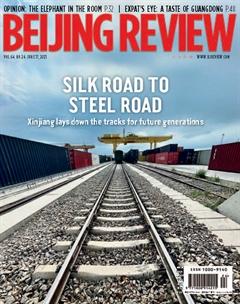DIVERSITY,THE XINJIANG DNA
By Li Fangfang

Before she graduated from the School of Visual Arts in New York City, one of the leading art institutions in the U.S., Xinjiangborn photographer Hailun Ma gained a new awareness of her hometown in northwest China. “So-called ‘high fashion is far removed from my own life. I want to rebuild my connection with fashion photography,” Ma said.
In 2018, Ma returned to Xinjiang Uygur Autonomous Region. In addition to two suitcases stuffed with luxury clothing shed brought from New York for her shooting project, she also brought with her a broader vision to trace her childhood memories.
She hopes to equip people with new perspectives on what Xinjiang really is, aiming for those both in and outside the know. “Xinjiang is developing. Its not just an online search result when youre looking for ‘Uygur people or ‘beautiful scenery,” Ma told ThePaper.cn. Her internationally driven aesthetic view also empowers her with the ability to spot those fresh angles overlooked by locals.
Im where I come from
South Xinjiang, which features the most pronounced Uygur characteristics, became Mas top pick to shoot location-wise. “I grew up with Uygur neighbors when I was young and was always fascinated by their culture and coloforful clothes,” she said.“Older ladies would often put money in their stockings. I could always tell whether female neighbors had gone out or not by smelling their fragrance left in the building,” Ma recalled. She grew up in Urumqi, the regions capital city, and left for New York at the age of 18 to start her eight-year study there.
Her first Xinjiang series, entitled Hometown, garnered much attention in terms of her sophisticated blend of the trivialities of Xinjiang local life and the at times travesties of modern fashion. The series made its public debut at the opening of Xinjiangs Gaotai Gallery, the first contemporary gallery in the region, in November 2019.
“Artists from Xinjiang tend to have a strong sense of color, rarely seen in artworks rooted from other parts of China,” Musa Ma, Curator of the Gaotai Gallery, told Beijing Review. Their rich and often flamboyant palettes possibly result from a combination of the regions long hours of sunshine and other natural resources, according to him.
Musa Ma was born in Tacheng, a small town in the northern part of Xinjiang. He and Hailun Ma have both studied and worked overseas so they shared the artistic vision of “Urumklyn” to depict the parallels between Urumqi and Brooklyn, Xinjiang and New York.

